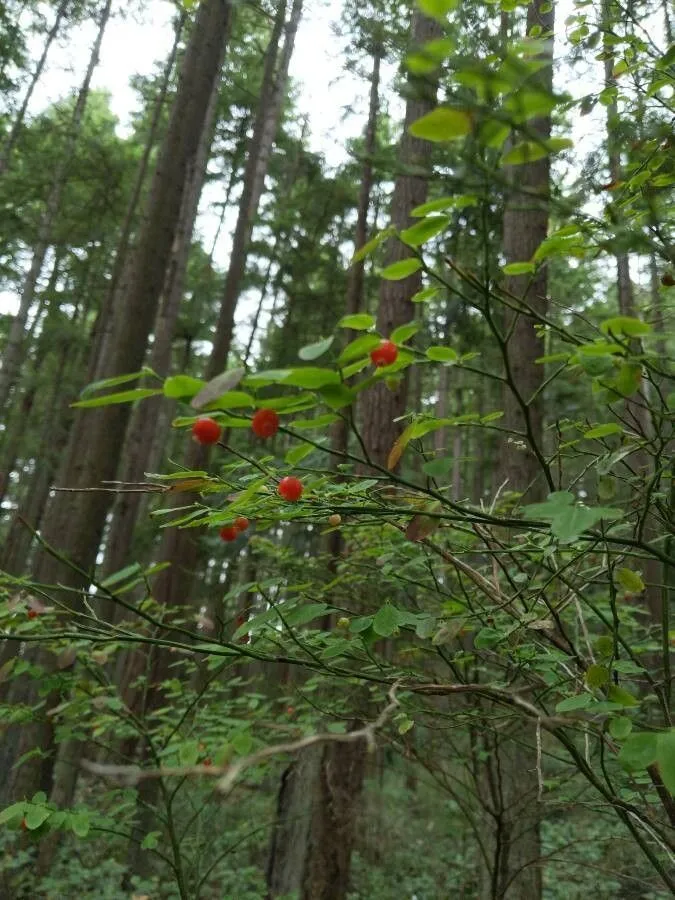
Author: Sm.
Bibliography: A.Rees, Cycl. 36: n.º 3 (1817)
Year: 1817
Status: accepted
Rank: species
Genus: Vaccinium
Vegetable: False
Observations: Alaska to California
Red-huckleberry, scientifically recognized as Vaccinium parvifolium, is a remarkable member of the Ericaceae family. This deciduous shrub is a prominent feature of the forests stretching from Alaska down through California, thriving predominantly in the moist, temperate climate of the Pacific Northwest.
The plant is characterized by its slender branches and bright green, ovate leaves which provide a vibrant contrast to the more somber hues typical of forest undergrowth. Red-huckleberry is notable for its small, bell-shaped flowers that appear in spring, adding a delicate beauty to its otherwise modest appearance. These flowers later give way to its most distinctive feature: round, bright red berries that ripen in mid to late summer.
The berries, while tart, are edible and have been traditionally harvested by Indigenous peoples for both food and medicinal purposes. They can be eaten fresh or used in various culinary applications such as pies, jellies, and beverages. Additionally, these berries are a valuable food source for a variety of wildlife, including birds and mammals, thus playing a crucial role in the local ecosystem.
Red-huckleberry plants prefer acidic, well-drained soils and are often found thriving on decaying wood or amongst the understory of coniferous forests. They possess a remarkable adaptability to different light conditions, from full sun to deep shade, making them a versatile addition to woodland gardens and restoration projects aiming to support native plant communities.
For gardeners and naturalists looking to cultivate Red-huckleberry, it is essential to mimic its natural habitat to some extent. Ensuring the soil remains consistently moist and somewhat acidic, and avoiding overly alkaline conditions, will promote healthy growth. As with many native plants, once established, Red-huckleberry requires minimal maintenance and is relatively pest-resistant.
The historical documentation of Red-huckleberry, including the comprehensive description by A. Rees in Cyclopaedia of 1817 under the authorship of Sm., reflects the long-standing interest and study of this plant. It’s not only appreciated for its aesthetic qualities but also for its ecological significance and utility in traditional practices.
In summary, Red-huckleberry is a plant deeply intertwined with the natural and cultural landscapes of the Pacific Northwest. Its resilience, beauty, and ecological importance make it a cherished species among botanists, gardeners, and ecological restoration enthusiasts alike.
Eng: red huckleberry, red-huckleberry, red bilberry
Fra: airelle à petites feuilles, airelle rouge
En: Red-huckleberry, Red huckleberry, Red Blueberry, Red bilberry
Zh: 小叶越橘
Fr: Airelle à petites feuilles, Airelle rouge
Ru: Вакциниум мелколистный
Zh-hant: 小葉越橘
Taken Jul 3, 2018 by Randy Huey (cc-by-sa)
Taken Aug 1, 2019 by Loren Wang (cc-by-sa)
Taken Jun 28, 2020 by Lucas Rohm (cc-by-sa)
Taken Aug 4, 2020 by Hayden churchill (cc-by-sa)
Taken Jun 26, 2021 by Dylan Gunning (cc-by-sa)
Taken Apr 9, 2022 by Maarten Vanhove (cc-by-sa)
Taken Mar 23, 2015 by Hayden churchill (cc-by-sa)
Taken Aug 1, 2019 by Loren Wang (cc-by-sa)
Taken Apr 29, 2019 by Eli Small (cc-by-sa)
Taken Jan 29, 2016 by EOL − chlorophilia (cc-by-nc)
Taken Jan 29, 2016 by EOL − chlorophilia (cc-by-nc)
Taken Mar 4, 2016 by EOL − Lauren Magner (cc-by-nc)
Taken Aug 4, 2020 by Hayden churchill (cc-by-sa)
Taken Dec 7, 2014 by EOL − podiceps (cc-by-nc)
Taken Apr 29, 2019 by Eli Small (cc-by-sa)
Taken Jul 22, 2021 by bob forager (cc-by-sa)
Taken Jul 3, 2021 by Bianca Huntley (cc-by-sa)
Taken Jul 22, 2020 by sarah wall (cc-by-sa)
Taken Mar 20, 2016 by EOL − galianotwins (cc-by-nc)
Taken May 1, 2022 by Henry Armitage (cc-by-sa)
Taken Apr 29, 2019 by Eli Small (cc-by-sa)
Taken Jul 25, 2015 by EOL − Wendy Feltham (cc-by-nc)
Taken Aug 1, 2020 by Julie Holt (cc-by-sa)
Growth form: Multiple Stem
Growth habit: Shrub
Growth rate: Slow
Ph maximum: 7.5
Ph minimum: 5.0
Family: Myrtaceae Author: (F.Muell.) K.D.Hill & L.A.S.Johnson Bibliography: Telopea 6: 402 (1995) Year: 1995 Status:…
Family: Rubiaceae Author: Pierre ex A.Froehner Bibliography: Notizbl. Bot. Gart. Berlin-Dahlem 1: 237 (1897) Year:…
Family: Sapindaceae Author: Koidz. Bibliography: J. Coll. Sci. Imp. Univ. Tokyo 32(1): 38 (1911) Year:…
Family: Asteraceae Author: A.Gray Bibliography: Pacif. Railr. Rep.: 107 (1857) Year: 1857 Status: accepted Rank:…
Family: Fabaceae Author: Medik. Bibliography: Vorles. Churpfälz. Phys.-Ökon. Ges. 2: 398 (1787) Year: 1787 Status:…
Family: Aspleniaceae Author: (Cav.) Alston Bibliography: Bull. Misc. Inform. Kew 1932: 309 (1932) Year: 1932…